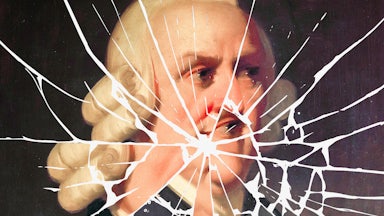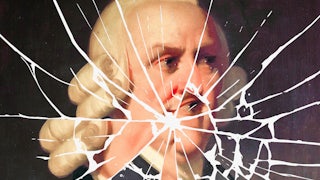“I have this fear that one of these years, I’m going to stand up here and have nothing to say except, ‘We’ve run out of rock history to strip-mine.’” Jeff Gaspin, then executive vice president at VH1, said this at a press conference more than 20 years ago. He was quoted, by reporter Mark McGuire, in a syndicated article about the enduring popularity of the TV rock saga, both real-life and fictional.
At the time, MTV was about to premiere its first scripted, hourlong drama, Live Through This, about a fictional 1970s rock band who reunite with help from their grown-up children—all of whom fit snugly within MTV’s youthful demographic range. The show was designed to flatter Gen X sensibilities, sticking it to the Boomers while milking their cultural product. Pat Benatar and Graham Nash wrote songs for the fictional band, which the Orlando Sentinel dubbed “Fleetwood Slack.”
Obviously, Gaspin’s fear never came to pass. Live Through This was canceled after one season, but the same old stories are still in circulation; new platforms introduce new angles and present new incentives for reviving them. VH1’s Behind the Music has stalled, stopped, and rebooted on Paramount Plus. And now Prime Video will premiere Daisy Jones and the Six, a limited dramatic series about another fictional ’70s rock band, structured like a Behind the Music special. If Live Through This served, ultimately, to promote its network’s ethos, Daisy Jones does something similar for Jeff Bezos’s entertainment and retail empire.
The premise is this: Daisy Jones and the Six rose to the top of the charts in 1977 with their album Aurora, then split up, mysteriously, at the height of their fame. The show is mainly set in the ’70s, but is studded with “interview” footage with band members 20 years after the fact. Central to the drama are dueling lead singers, whose love-hate relationship is the band’s atomic center: Daisy Jones (Riley Keough), a free spirit who speaks her mind and tends toward excess; and Billy Dunne (Sam Claflin), an arrogant but well-intentioned family man who is tempted by excess—and by Daisy—but desperately wants to do right by his wife, Camila (Camila Morrone).
Daisy Jones began as a novel by Taylor Jenkins Reid, author of several hit books, including The Seven Husbands of Evelyn Hugo. It’s written in the style of oral history, and takes inspiration from Fleetwood Mac lore. For the show’s creators, the property was a slam dunk from the start. Co-creator and co-showrunner Scott Neustadter read the manuscript in 2017, before it was sold for print. He called his wife, Lauren Neustadter, the head of film and TV at Hello Sunshine, Reese Witherspoon’s production company. The following year they brought it to Jennifer Salke, still fresh in her role as the head of Amazon Studios, who ordered it to series. When the book was finally published, it was picked for Witherspoon’s book club, and a bestseller was born.
A recent New York Times profile describes just how high the expectations are. Meticulous sets, including a weeklong makeover of the Sunset Strip; thousands of wardrobe changes; a P.R. push that “hark[s] back to the era of big-studio budgets.” None of the actors was an established musician at casting, and some of them learned instruments for their roles, training intensively while production stalled during Covid. Blake Mills, a sought-after songwriter and producer, composed a real-life Aurora with help from Phoebe Bridgers and Jackson Browne. Bucking the odds for a fictional rock band, the music is actually good, combining a deep understanding of the era’s sound with a strong sensibility of its own. The album will be released by Atlantic Records. You can stream it on Amazon Music or order it on vinyl—along with a record player, a pair of speakers, and a shag carpet to listen on, should you find that you suddenly want one.
I quite liked Reid’s book. It makes all the sense in the world that Salke, Witherspoon, and the Neustadters liked it too. The past several years have seen a great boom in book adaptations, driven largely by the content demands of streaming services—financial setbacks will surely slow the pace, but likely won’t dull the appeal of ready-made stories. As Alexander Manshel, Laura B. McGrath, and J.D. Porter wrote in The Atlantic, this affects the form of fiction itself. By their criteria, Reid’s novel is eminently adaptable: It’s written almost entirely in dialogue; it boasts a colorful ensemble cast; it calls up a world that’s rich in visual detail and nostalgic allure. Reid even wrote the lyrics to Aurora, which are appended to the book.
The property is especially well suited to Amazon, which can’t boast the hit parade of Netflix, but can use its entertainment offerings “to lure you into its ecosystem and market other products,” as Lucas Shaw wrote in a newsletter for Bloomberg last year. It would make sense for the company to splash out on audiovisuals: Music, clothes, and props are the sorts of things you can merchandise. Daisy Jones, in addition to spawning an album, yields limitless spending prompts: Prime subscribers can order Reid’s back catalog, in print or audio; a copy of Rumors; a lava lamp. Just about everything but the cocaine.
Plenty of books are optioned, like Reid’s, long before they’re published; many are conceived from the get-go as a stepping stone to a screen deal. This circularity can benefit every stakeholder: With Witherspoon invested, Daisy Jones was positioned for bestseller status from the jump; by the time the show was in production, hundreds of thousands of readers couldn’t wait to see their favorite characters come to life. This is all well and good, until there’s a show to watch.
Reid’s premise may lend itself to the screen, but the qualities that make her novel effective—compelling interpersonal dynamics, characters who don’t know how to be good any more than we do—are harder to translate. There’s plenty of debauchery in the story, but mainly as a backdrop: The tensions are intimate, and kept mostly on a simmer. Since it is a novel, we accumulate our impressions of the characters’ feelings and motivations. But the show relies more on character declaration than development, and an array of clichés so hackneyed that they’re almost surprising to find in the wild.
Daisy Jones, we learn early on, is “broken.” She is broken because of her socialite parents. In a pivotal scene, we find little Daisy singing alone in her bedroom, while they throw a cocktail party in the next room. Suddenly her mother charges in to silence her, hissing, “No one wants to hear your voice.” It is strongly implied that Daisy will spend the rest of her life proving her mother wrong. A few scenes later, a teenage Daisy is lured into an empty hotel room by an older musician. “I just didn’t want to be that girl anymore,” she intones. Back in her bedroom, she picks up a pencil and, very literally, starts to write.
Billy is also “broken,” also by his parents: His father walked out on the family when he was a kid. We learn this when his dad shows up at one of the band’s early gigs, creating an opportunity for Graham (Will Harrison)—Billy’s brother and the lead guitarist—to punch him cathartically in the face. Billy finds a mentor in Teddy Price (Tom Wright), the band’s producer, who becomes a father figure to the kids he works with. We know this, because when the character is introduced—through footage from a talk show interview—the host says, “Teddy, you became a father figure to the kids that you worked with.”
It’s not as if the cast is uncommitted, or untalented. Tom Wright and Timothy Olyphant, who plays the band’s beleaguered tour manager, are veteran screen and stage actors; the show’s leads make the best of the material they’re given. Their efforts are sabotaged. Sometimes it feels deliberate. Take, for instance, the show’s unwillingness to age its characters appropriately for their interview segments—minus a wig or two, everyone looks the same in their forties as they did in their twenties. For Riley Keough and Sam Claflin, both actors in their thirties, the effect is more monotonous than disorienting. For Camila Morrone, playing Claflin’s wife, it’s bizarre, and almost insulting. She was under 25 when the series was shot; it’s as if somebody gambled that audiences would prefer to see her beauty undiminished than believe in her performance.
A built-in fan base can either add pressure or relieve it. Fans are easily disappointed, but—in theory—they’re easy to satisfy too. Scott Neustadter has adapted several books for the screen, including John Green’s The Fault in Our Stars. In an interview with Vanity Fair, he recalled asking Green, “What are the lines that are tattooed on people’s bodies that we must make sure are in this thing? … I would be so mad if someone adapted a book that I loved and didn’t do the right thing.”
What is “the right thing”? Molly Fischer, in a New Yorker essay on “I.P. TV,” described the paint-by-numbers feel of shows like The Staircase—true-crime franchises, optioned from magazine stories then spun into podcasts and streaming entities. “A grinding literalism threatens—a dutiful hitting of marks,” she writes. “Facts can come to feel like load-bearing elements of a rickety edifice.” The same principle holds for beloved fiction.
While it’s surely not what Neustadter meant, what I take from his sentiment is that Daisy Jones and the Six never had to be good, or even interesting to watch. Arguably, the less interesting it is, the better. A standout performance might compete with the fan ideal; an accurate account of ’70s backstage life—despite the excess, the show feels about as wild as an indie rom-com—would complicate the idealized era. The less engrossed viewers are, the more likely they might be to engage with other offerings.
When Jennifer Salke took her position at Amazon, one of her priorities was “big, addictive shows for women”—another selling point for Daisy Jones, which promises a female perspective on the male-dominated world of ’70s corporate rock.
I wasn’t expecting the series to handle this, or any relevant social issue, with intricacy or insight, for the simple reason that popular shows—even good ones—rarely do. It’s safer to stick to clichés than to risk being misunderstood, even if it misrepresents the people affected and degrades the surrounding discourse. From a cynical standpoint, stating the obvious makes a show relevant, and ingratiates it with viewers who already agree.
Daisy Jones’s approach is predictable: Bogeymanize the patriarchy, and make heroines of its targets. Scenes of sexual harassment are staged with all the nuance of an employee training video, and the show is littered with memeable moments of righteous indignation: “I’m not the muse, OK! I’m the somebody,” Daisy yells, minting a GIF.
Moments like these have the function, and the emotional impact, of action-movie explosions. Good guys and bad guys are neatly sorted—plucky feminist heroines versus sexist industry pigs—and it’s supposed to feel good to see one defeat the other. But action movies are fantasy; they don’t pretend to be otherwise. Daisy Jones has designs on realism, and it’s the pretension of seriousness that disturbs me, because the show has no meaningful relationship to reality. Ultimately it seems totally uninterested in ’70s gender dynamics, or anyone’s experience of living through the era, or human nature generally.
It is interested in preserving the value of its own intellectual property—as well as aligning with other valuable I.P. that Amazon doesn’t own but can sell you anyway. The show is tied to a platform that can churn a commodity out of just about any association you make. With this in mind, the show’s many references and homages start to feel less like components of a story than attempts at brand alliance. Between Mills’s compositions, the series makes liberal use of classic rock standards, which is certainly nothing new in big-budget screen projects, or in advertising—it’s been many years since “Go Your Own Way” first appeared in a TV commercial. Still, when I hear “Gold Dust Woman,” or “I Feel the Earth Move,” it feels wrong in a way that I haven’t yet been desensitized to. It’s not just that I feel manipulated, or as though my personal associations are being supplanted. More like a switch has been flipped, and now I can only hear these songs as yet more I.P. That’s certainly a valid way of looking at popular culture, but a deadening one, all the same.
Throughout this review, I’ve been ascribing intention to “the show,” as if it’s a thinking, scheming agent. There is no single agent, and I don’t doubt that everyone involved with the series cared a lot, and did their best, whatever their job happened to be. Many people did excellent work on this, and I feel for them. Because I think that, as amorphous as it might be, there is an intention behind this show that works against the vitality of its personnel.
There’s no easy line between art and commerce; and nothing wrong, necessarily, with making art that lends itself to commercial objectives. That’s how things get made, and how artists get paid. Reid’s business instincts align smoothly with her creative ones. She wrote a good book—why wouldn’t she want to see it become a hit series, or hear the album of her dreams? Still, the show feels parasitic of her work, to say nothing of its real-life inspirations. And the show’s blandness feels sinister to me, a little like reading an essay composed by ChatGPT. It feels like a dupe of human sensibility; it points to a void.
Recently I talked to Joe Cobden, an actor who has worked in film and TV for more than 20 years. His first show was Live Through This, the short-lived MTV drama. “Even though it was my first gig, I could tell that everyone was cynical,” he said. “That authenticity was unimportant, as if none of the executives had ever been to a rock show, or knew anything about rock music.” What he meant is that hack TV is inevitable, and that goes for every format—streaming, network, public broadcasting. What’s changed isn’t quality, but volume.
Cobden referred to a lecture by the director Anthony Minghella, who worried, even in 1997, about an industrial glut of storytelling, surpassing anyone’s capacity to process it all. Streaming, of course, has produced a deluge. As audiences, we tend to concern ourselves with how fiction models behavior; but fiction models the world for us, in ways more profound and insidious. When fiction is driven by market forces, it remakes the world by their logic.
Maybe this point seems quaint now—not because it’s untrue, but because it’s always been true, and it seems like there’s nothing to be done. At the very least, we can keep trying to identify the intention.






